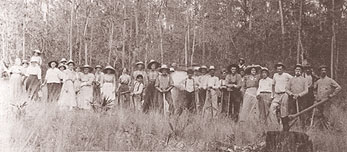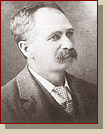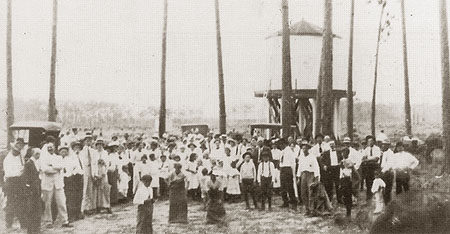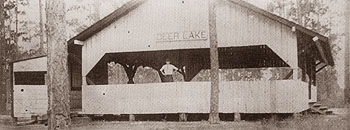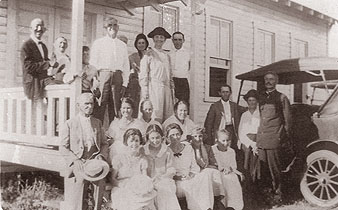|
The History of Lutz - Page 7 |
|
Read the left and right panes before scrolling down to the next levels. Click links to view related photos, use your back browser button to come back to this page. |
|
Click on links in text, they lead to more pictures |
|
|
||
|
The first permanent resident of the new North Tampa community was Mike Riegler, a 30 year old German immigrant who arrived in January of 1911 and settled on present day Wallace Road. Riegler cleared his land and started an orange grove and nursery that would quickly become the largest in the area.
Mike Riegler reads the paper under the shade of his banana tree in front of his home on Wallace Road, 1910's. |
Scattered throughout the area were families who had arrived in the late 1800's whose descendants still live in Lutz and have roads or lakes named after them. Cooper, Meyer, Strickland, Redbrook, Denison, Newberger, Frizzell, McDonald, Grantham, Metcalf, Hill, Ryals, Ellis, Whitman and Pearce.
Many of the early settlers of 1911 found old seedling orange groves already growing when they arrived. C. E. Thomas used the citrus industry to help many of the settlers get out of financial jams. He started a number of nurseries in the area; the first seven on acreage west of the Lutz United Brethren Church. He eventually had the second largest citrus nursery in the state. Many of the early settlers made their living by raising citrus of all kinds. Most planted citrus groves on their own properties, or worked on a grove nearby. |
|
|
When Guy Sparlin brought his family to the area in 1911, there were only three houses on the town site, located to the south of First Avenue S.W. at the junction of the railroads. Several families arrived in November of 1911; the Roscoe and Frank Potter families, the Goheens, H. E. Henke, Dr. W. J. Hood, and H. T. Vernon.
1911 photo described as L to R, Harry Jackson, HT Henke and HT Vernon looking over some cleared land. However, it is likely that this is L to R: Herb T. Vernon & Land Co. salesmen J.E. Martin & possibly a Mr. Little. See why
|
By the fall of 1911, C. E. Thomas had built a school large enough for 75 students and presented it as a gift to the school district trustees. It opened for the 1911-1912 school year to 35 students.
The teacher, Miss Callie Barry, was only 18 years old but maintained discipline with a ruler and a persimmon switch. She was paid $30 a month. At the end of the 1911-12 school year, she handed out a souvenir booklet (page 1 & 2) (page 3 & 4) with her picture on the front, and inside was a short note from her, a list of the students names, and a poem titled "The Close of School."
The 1912-1913 class picture shows teacher Isabel Wyandt. Fred Polen began teaching in 1913 but later gave it up to become a mail carrier.
|
|
|
Guy V. Sparlin's photographs preserved much of the early history of Lutz and the surrounding area. Oval photo below shows Guy Sparlin (right) posing with Dr. Hood, owner of the Golden Rule Store.
Guy Sparlin's restaurant was on the north side of the train depot. Right: Guy Sparlin in front of his restaurant, with camera. Circa 1910's. |
||
|
By the end of 1911, there were 30 buildings in the community of North Tampa. Besides the homes, school and train depot, there were churches, a grocery store, and a hotel. P. E. Matthaey built the first business, North Tampa Stores, in 1911. He sold groceries, hardware and dry goods and also had a lunch counter. It was a two-story building on the south side of First Ave. SW, just east of the fellowship hall of the First United Methodist Church. D. F. Johnson opened the first hotel in 1911. Built so prospective buyers would have a place to stay, it was also home to new landowners waiting for their homes to be built. After Johnson, proprietors were Lipsey, McDowell, Simmons, Wallace, Parrish, Harvill, Richter and Lawson. |
The North Tampa hotel became the Lutz hotel and then the Lutz Boarding House, seen here in the 1950's when owned by the Parrish family. |
|
|
1913 photo
|
Sydney sits on his grandfather Holcumb's lap.
|
|
|
C. E. Thomas also donated the land for the cemetery, just north of the town's center on the east side of present day US 41. The original property was a strip 230 feet by 80 feet, which now is the westernmost part of today's cemetery. The only entrance was a sandy road at the end of 2nd street N.E. The land was cleared by several hard-working pioneers; clearing the land was a challenge because of the large pine trees on the property. One was so large its stump stayed on the property for years. Old-timer Worth Johnson said it was big enough for 6 men to stand on.
|
A man named Mr. Nims has the misfortune of being the first to be buried there in 1914. Ira Goheen and his father Alfred made his casket.
Cemetery maintenance was the responsibility of the community. Once or twice a year they would show up on clean-up day; the men with hoes, shovels and scythes, and the women with sandwiches and lemonade.
Today, 3 generations of Goheens are buried there, along with other early settlers such as Herbert Vernon, H. E. Henke, Harry Jackson and wife Mary E., postmasters E. Harvey Drake, William Vosburgh and mail carrier Fred Polen. Photo at left purported to be Mr. Nims' funeral, 1914, but appears more to be an aforementioned maintenance gathering
|
|
|
The first "North Tampa" July 4th celebration was held in 1912 at a spot south of the county line at the Tampa Northern RR water tower.
The whole community turned out for the first 4th of July celebration. The Tampa Northern Railway water tower can be seen in the background.
|
||
|
Later in 1912, pioneers built an open-air structure called the "Deer Lake Pavilion" where they held their first Thanksgiving celebration. The pavilion was south of present day County Line Road at the west side of the Tampa Northern Railway tracks. Peaceful during the day, the Deer Lake Pavilion turned into a lively gathering place in the evenings in the 1910's. |
|
|
|
|
Several of the pioneers started a Sunday school in Father Stemper's abandoned church. In the fall of 1912, Rev. Archie Chapman founded the United Brethren Church that met in the original schoolhouse. He organized another one to the south in Chapman, on the road that led from his house to present day US 41, which bears his name, Chapman Road. At the time, he was the only preacher around. The church, road and Chapman depot all were situated clustered together a short distance north of where the Holmes Nursery stood, on present day US 41.
At left, the Chapman congregation with Archie sitting on the railing, early 1910's.
|
|
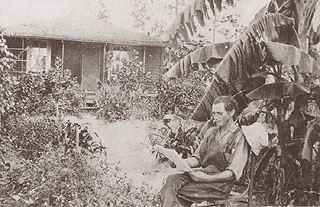
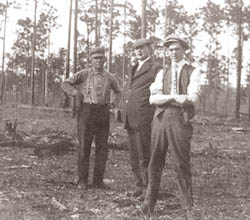
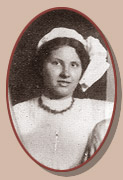
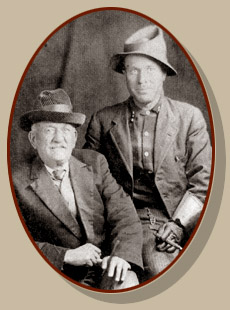
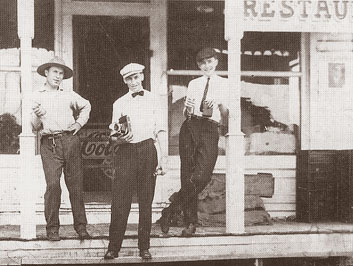
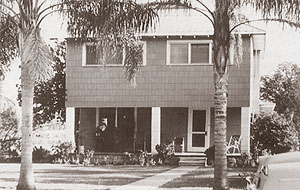
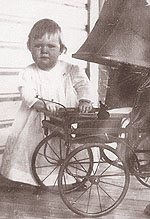 The first baby born in North Tampa was
Donna Sparlin, May 1, 1912.
The first baby born in North Tampa was
Donna Sparlin, May 1, 1912.
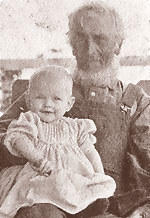 A week
later on May 8th, 1912, the first boy was born, Sydney Goheen
A week
later on May 8th, 1912, the first boy was born, Sydney Goheen 